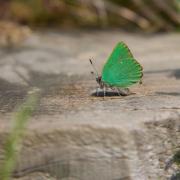To create sculptures as tiny as those crafted by Willard Wigan, you need to have a very big heart

“I say!” murmured Horton. “I’ve never heard tell
Of a small speck of dust that is able to yell.
So you know what I think?... Why, I think that there must be
Someone on top of that small speck of dust!
Some sort of a creature of very small size,
Too small to be seen by an elephant’s eyes…
Horton Hears a Who, by Dr Seuss
When I meet micro-artist Willard Wigan and hear how, as a small boy, he was inspired to make a home for ants in his back garden, Horton – the big-hearted elephant of Dr Seuss’s children’s book – immediately comes to mind.

For those not familiar with the story of Horton Hears a Who, the eponymous hero discovers a miniscule town called Whoville existing on a speck of dust and strikes up a friendship with the tiny beings that inhabit it. Of course, no-one else is aware of the Whos of Whoville, but Horton hears one small voice and vows to do all in his power to protect them. The tale is essentially about equality, and we hear Horton on many occasions utter, “A person’s a person, no matter how small.”
Willard Wigan was born in Wolverhampton in 1957, the son of a Jamaican factory worker, and one of seven children. His learning difficulties – he has autism and dyslexia – were undiagnosed during his school years and so he found himself cruelly criticised by teachers.
“I was blessed with a condition called Asperger’s,” he says, as we speak in a gallery at Broadway Museum where his work is being exhibited. “It meant that academically I couldn’t express myself the same way as other kids. Autism wasn’t diagnosed back in 1962, and so if you couldn’t read and write you were called a failure.
“The teachers used me as an exhibit,” he continues, “and there was one teacher in particular who used to take me round the whole school and tell all the kids about me.” The trauma of this, and being labelled a failure, led to Willard withdrawing into himself and not speaking, as he believed that nothing he said mattered.
“My body was at school, but my mind wasn’t,” he says, “and so I decided to take them both away.”
Finding a gap under the fence at the bottom of the playground, aged just five, he crawled under and escaped to a field with a pond that was alive with nature – water boatmen, sticklebacks, dragonflies. “I just sat there, watching them, and I felt really good, so I started to explore a world that would never criticise me.”
Returning to his own back garden (climbing over the fence while his mum was at work) to see his much-loved dog Maxie, he watched as his companion began digging holes, revealing an ants’ nest.
“I got upset,” he says, “as I thought the ants were now homeless, so I started making houses for them.”

Finding his dad’s discarded razor blade, he broke off a shard and started carving homes for the ants from splinters of wood. He decided the queen ant needed a palace complete with archways and turrets, the young ants needed a school with see-saws, swings and a merry-go-round, all of the houses needed tables and chairs, and before he knew it he had created a whole village, all in the space of one school day.
When his mother returned home he became anxious that he was going to be in a lot of trouble – “When you got hit by my mum, you’d see more stars than Patrick Moore!” – but he needn’t have worried as her initial anger at him absconding from school turned to amazement when she saw what he had made. Willard remembers the words she uttered then and continued to say to him throughout his career: “If you make them smaller, your name will get bigger.”
So began his journey to make things smaller, and smaller, and smaller.
He went on to carve Beatrix Potter characters on the end of a toothpick, charging threepence for the other kids to have a look and soon word had got round about Willard and his wonderful creations.
Aged nine, Willard ‘acquired’ his first microscope, courtesy of school, after the science teacher said to him his brain was “smaller than a caterpillar’s.” Justification enough to ‘borrow’ it, in my books.
He went on to make smaller and smaller pieces, even creating all the characters from Great Expectations on a toothpick. But his fearsome and hugely respected mum just said each time, “It’s too big; make it smaller.” And so he was driven to try to impress her more with each miniscule creation.
“I never got bitter,” he says, smiling, “I got better.”
He recalls, however, how he found difficulty living with his colour as a child, with the likes of characters such as Alf Garnet and the racism that was rife at the time.

“I started rubbing at part of my face with wire wool until it bled,” he says, thoughtfully, hoping that he could remove the colour from his skin, “until my mum saw it and went crazy.” It was a hard time for a coloured boy growing up in predominantly white Wolverhampton in the 60s.
Leaving school, aged 15, Willard went to work in a factory. For a few years he stopped making his sculptures, entering a depressive state, feeling as though he was “sinking in quicksand” and anxious to know what the future held for him. He made a conscious decision, though, to be positive and to enjoy being alive. His persistent personality (“You know when you’ve been ‘Willarded’!”) endeared him to people, though, and he soon found many wanting to help him by supplying tools and materials.
He recalls seeing a television programme with Alan Whicker where he heard the Biblical quotation ‘it is easier for a camel to go through the eye of a needle than for a rich man to enter the kingdom of God’. And so, quite naturally, with the voice of his mum in his ears saying that everything he had made to date was “too big”, he created a camel in the eye of a needle. “The camel looked like something crossed between a giraffe and an elephant,” he says laughing, “and my mum still said it wasn’t good enough.” So, he went on to make three camels in a needle’s eye, then four, five, six… and, understandably, vowed not to show his work to his mum any more.
His generosity of spirit is evident while we’re in the gallery when he strikes up a conversation with a nurse who is viewing the pieces. Willard says to him how he admires and respects the work they do, and offers to donate a sculpture for them to auction off to raise funds for the hospital. It has to be said his genuine warmth and electric personality make him instantly likeable.
Willard has gone on to appear on British and American chat shows, given TED talks, had his work featured in global advertising campaigns, and was presented with an MBE – for services to art – by Prince Charles in 2007. In 2012, he was commissioned to replicate the Coronation Crown in honour of the Queen’s Diamond Jubilee (now housed at Buckingham Palace), and last year received an honorary doctorate from the University of Warwick in recognition of the significant contributions that he has made to art and sculpture.
When you see the pieces up close, you get a sense of supernatural powers at play; how on earth can someone create something so minute? How can anyone’s eyesight be that keen, and how is it possible to have hands steady enough to carve detailed shapes in something so very tiny it can’t be seen with the naked eye? But Willard has developed a technique where he enters a meditative state, slowing down his heart, and only working in between pulses and breaths (once, early on in his career, he breathed in too sharply and inhaled one of his pieces!).
For hour upon hour he would do things to get in a zen-like state, such as continuously threading a needle, balancing a piece of wood on his finger, and holding his breath for as long as possible. “When you’re doing tiny little things,” he continues, “you have to have maximum dexterity and be as still as you possibly can. In order to create this type of work, you have to be like a tiny god in your own little world.”
He does admit to not enjoying the process of creation, but loves the outcome and the reaction he gets from seeing the stunned expressions when people view his pieces for the first time.

“All this work here,” he says, gesturing towards the rows of microscopes in the gallery and looking me straight in the eye, “is a labour of… hate.”
The semi-permanent exhibition Willard Wigan: In the Eye of a Needle is a collaboration between Broadway Museum and Art Gallery and Broadway Luxury.
Neighbouring Broadway Luxury also has two of his works on display, including one of the iconic Broadway Tower recreated from a tiny piece of Cotswold stone from the tower itself, and placed in the eye of a needle.



























